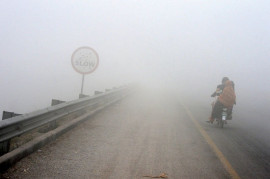
It had initially set the oil and gas revenue target at Rs409.61 billion for the outgoing fiscal year, but later revised it downwards to Rs378.90 billion following a sharp fall in crude prices.
It has achieved the target set for petroleum levy, natural gas development surcharge and gas infrastructure development cess (GIDC). However, this did not include the general sales tax (GST) on petroleum products whose collection rose from Rs25 billion to Rs30 billion in the wake of increase in the tax rate.
To avoid revenue loss, the government had set GST in terms of percentage and later revised its rates upwards.
The royalty on oil and gas is an area that may dent hopes of meeting the revenue target next year. Provincial receipts on this account as well as gas development surcharge could fall because of the decline in crude oil prices.
In the outgoing year 2015-16, the government had set the target at Rs99.6 billion for royalty on oil and gas, discount on local crude oil, windfall levy on crude oil and petroleum levy on liquefied petroleum gas. However, it was later slashed to Rs66.9 billion.
For the next year, the projection is even lower at Rs64.9 billion because of spillover effects of lower international oil prices on the royalty on locally produced crude oil.

Consumption
Encouraged by the price fall, the consumption of petrol rose and came close to the demand for high-speed diesel. In May 2016, petrol consumption stood at 525,000 tons compared to 585,000 tons for high-speed diesel.
“With a petroleum levy of Rs10 on every litre of petrol, the government is receiving Rs13 billion a month against Rs10 billion last year,” said an official. “It is a major contributor to the revenue receipts.” A higher target of Rs150 billion has been set for petroleum levy collection for the next year due to increase in the consumption of oil products. For the outgoing year, the target was Rs135 billion.
Under the head of GIDC, the government expects to receive Rs145 billion in the next fiscal year, a figure that has been kept unchanged compared to the outgoing year. The funds gathered from this source will be spent on gas import projects like liquefied natural gas and pipelines from Iran and Turkmenistan.
The gas development surcharge, which is the difference between the prescribed and selling prices of gas that goes to provinces, is expected to bring Rs35 billion next year. In the outgoing year, its target was Rs32 billion.
Crude oil production in the country has jumped ranging between 80,000 and 100,000 barrels per day, but despite the spike, royalty collection has not been up to the mark in the outgoing fiscal year.
Of the revenue collection on petroleum products, Sindh will get Rs54.6 billion, Khyber-Pakhtunkhwa Rs17.1 billion, Balochistan Rs14.23 billion and Punjab Rs5.6 billion on account of gas development surcharge, royalty on crude oil, royalty on natural gas and excise duty on natural gas.

Published in The Express Tribune, June 4th, 2016.
Like Business on Facebook, follow @TribuneBiz on Twitter to stay informed and join in the conversation.



1734945455-0/Untitled-(88)1734945455-0-165x106.webp)
1734944224-0/Untitled-(87)1734944224-0-165x106.webp)
1734899716-0/image-(15)1734899716-0-270x192.webp)



1734899549-0/image-(16)1734899549-0-270x192.webp)






1734778885-0/Untitled-(10)1734778885-0-270x192.webp)






COMMENTS
Comments are moderated and generally will be posted if they are on-topic and not abusive.
For more information, please see our Comments FAQ